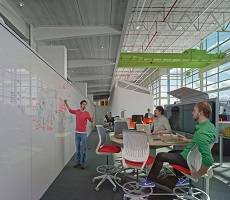August 27, 2014
Lack of regional commercial property could hamper UK growth
 Although construction is on an upward trend, the development of commercial property lags behind, and the situation is particularly challenging in the West Midlands. According to JLL and Glenigan’s inaugural Commercial Construction Index, total construction starts by value, year end Q2 of 2014 were 15 per cent down compared to Q2 of 2013 at £2.03 billion. Graham Taylor, director of JLL’s Birmingham Buildings & Construction team, explained that the volume of commercial property being started has not risen substantially since the recession. Birmingham, Leeds and Manchester are already experiencing a shortage of Grade A office space – with much of the shortfall due to a drop in construction activity compared to the early to mid 2000’s. He said: “Rising corporate confidence means that many companies are looking to upgrade their workplaces. The corporate world is increasingly recognising that well-designed modern offices can be a key driver of productivity and staff retention, two major strategic concerns.”
Although construction is on an upward trend, the development of commercial property lags behind, and the situation is particularly challenging in the West Midlands. According to JLL and Glenigan’s inaugural Commercial Construction Index, total construction starts by value, year end Q2 of 2014 were 15 per cent down compared to Q2 of 2013 at £2.03 billion. Graham Taylor, director of JLL’s Birmingham Buildings & Construction team, explained that the volume of commercial property being started has not risen substantially since the recession. Birmingham, Leeds and Manchester are already experiencing a shortage of Grade A office space – with much of the shortfall due to a drop in construction activity compared to the early to mid 2000’s. He said: “Rising corporate confidence means that many companies are looking to upgrade their workplaces. The corporate world is increasingly recognising that well-designed modern offices can be a key driver of productivity and staff retention, two major strategic concerns.”






 The recent Cabinet reshuffle in the UK Government won’t alter one fact; politicians simply don’t get it when it comes to technology, the workplace, the way people work and the needs of small businesses. Once you dismiss the paranoid idea that they DO get it but don’t care because they’re too busy looking out for The Man, you have to conclude that one of the big problems they have (this won’t go where you think) is that they don’t understand anything about technology and work, especially when it comes to emerging technology, the working lives of individuals, the needs and functions of small businesses and the fact the self-employed exist at all. These things exist outside the bubble. This is obviously a problem because they are implementing policies and making big, uninformed and anachronistic decisions about the things that shape every aspect of our lives, help to define us as people and determine how companies and individuals function. Here are just three examples.
The recent Cabinet reshuffle in the UK Government won’t alter one fact; politicians simply don’t get it when it comes to technology, the workplace, the way people work and the needs of small businesses. Once you dismiss the paranoid idea that they DO get it but don’t care because they’re too busy looking out for The Man, you have to conclude that one of the big problems they have (this won’t go where you think) is that they don’t understand anything about technology and work, especially when it comes to emerging technology, the working lives of individuals, the needs and functions of small businesses and the fact the self-employed exist at all. These things exist outside the bubble. This is obviously a problem because they are implementing policies and making big, uninformed and anachronistic decisions about the things that shape every aspect of our lives, help to define us as people and determine how companies and individuals function. Here are just three examples. The UK’s public sector spends almost twice as much on outsourced services as the country’s private sector, according to research from the
The UK’s public sector spends almost twice as much on outsourced services as the country’s private sector, according to research from the 














August 12, 2014
Five sectors, one challenge: The importance of high staff morale
by Simon Prince • Comment, Workplace